Table of Contents
Introduction and Importance of Power Factor
In today’s electrical systems, electrical energy is almost entirely generated, transmitted, and distributed in the form of AC (Alternating Current).
This makes power factor an important topic in electrical engineering.
Most loads—such as induction motors, arc lamps, and other inductive equipment—generally have a low and lagging power factor.
When the power factor is low, the current increases,
which causes higher active power losses in every part of the power system—from the generator to the end-use equipment.
This situation is undesirable from both economic and engineering perspectives.
Therefore, to keep the supply system efficient, the power factor must be maintained as close to 1 (Unity) as possible.
A high power factor not only saves energy but also reduces costs and power losses.
Definition of Power Factor
In an AC circuit, the cosine of the phase angle (φ) between voltage and current is called the power factor.
That is,
Power Factor = cos φ
Usually, there is some phase difference (φ) between voltage and current in an AC circuit.
- If the circuit is inductive, the current lags the voltage,
and the power factor is called a Lagging Power Factor.
✅ Bullet point: The closer the power factor is to 1 (Unity), the more efficient, cost-effective, and energy-saving the electrical system will be.
If the circuit is capacitive, the current leads the voltage, and the power factor is called a Leading Power Factor.
In an inductive circuit, the current I lags behind the voltage V by an angle φ.
This current can be divided into two components:
- I cos φ – In phase with the voltage
- Known as Active Power or True Power
- This is the real useful power that performs actual work.
- I sin φ – 90° out of phase with the voltage
- Known as Reactive Power or Wattless Power
- This power does no useful work, but it is involved in the exchange of energy within the system.
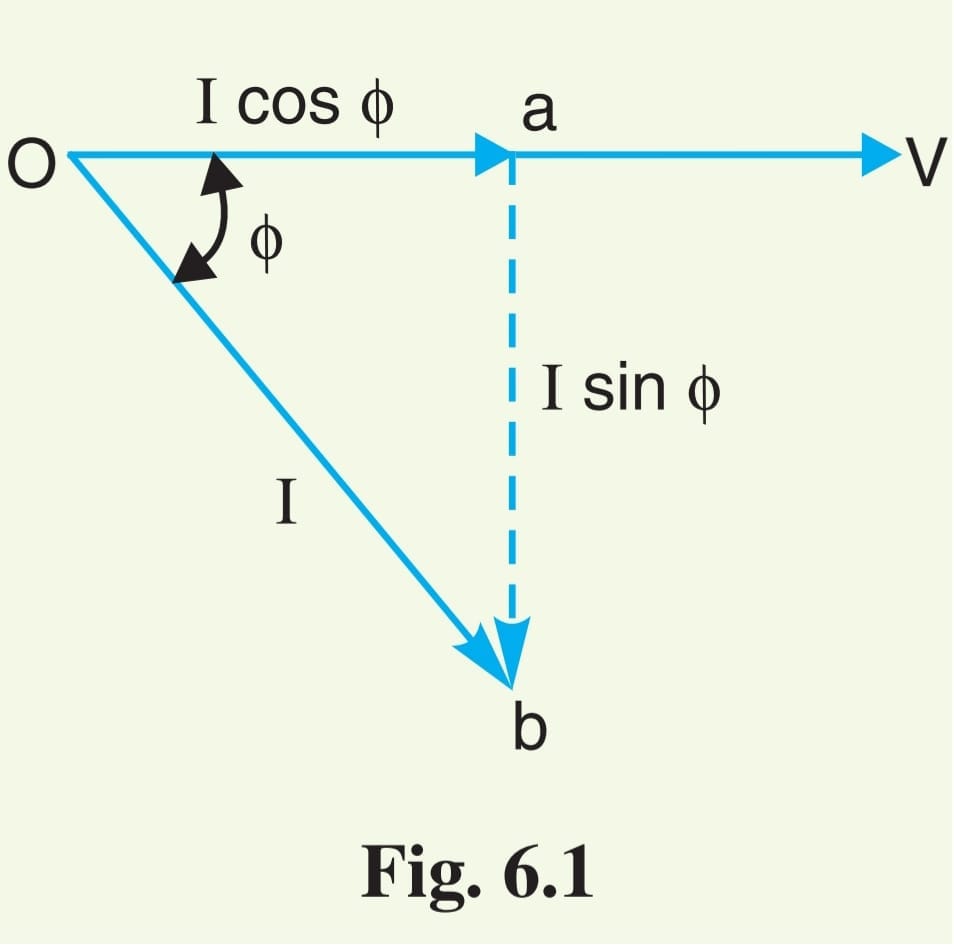
✅ Key Facts
- The reactive component (I sin φ) directly affects the power factor.
- The lower the reactive current, the higher the power factor.
- The power factor can never exceed 1.
- While stating the power factor, the words lagging or leading are usually added.
Example: 0.5 p.f. lagging
It can also be expressed in percentage:
Example: 0.8 lagging = 80% lagging
Power Factor Triangle
To better understand the power drawn by an AC circuit, the current triangle is multiplied by the voltage V to form the power triangle (OAB).
In this triangle, the three power components are:
- OA = V I cos φ → Active Power (kW)
- AB = V I sin φ → Reactive Power (kVAR)
- OB = V I → Apparent Power (kVA)
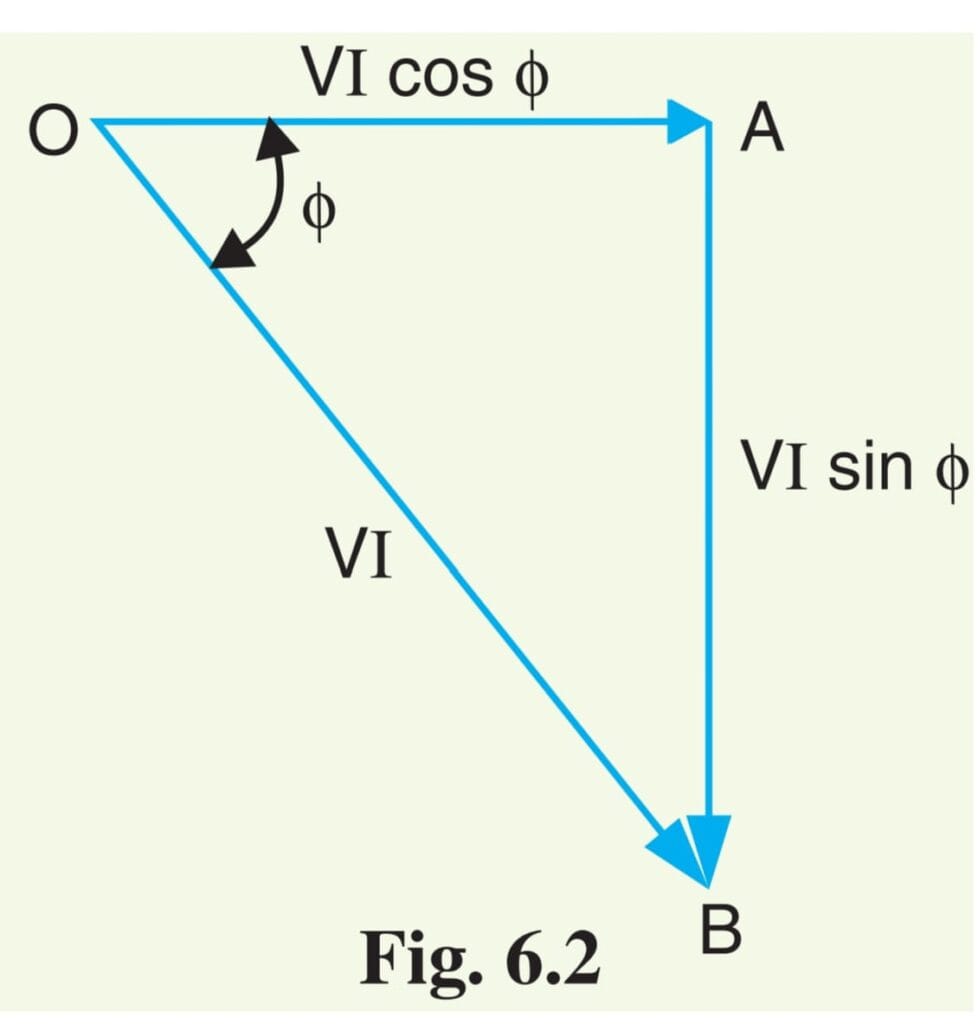
Power factor can be easily understood through this example.
Mac is pulling a heavy load
His actual effort in the forward direction, or Working Power (kW), represents the force that actually moves the load.
But Mac’s shoulder isn’t in a perfectly straight line, so the load also pulls slightly upward. This upward pull creates a force called Reactive Power (kVAR). This force doesn’t move the load, but simply creates additional stress in the system.
The total power being pulled by Mac, called Apparent Power (kVA), is actually the vector sum of both kW and kVAR.
This relationship is shown in the Power Triangle (Figure 3), where the angle between kW (actual power), kVAR (reactive power), and kVA (apparent power) determines the Power Factor.
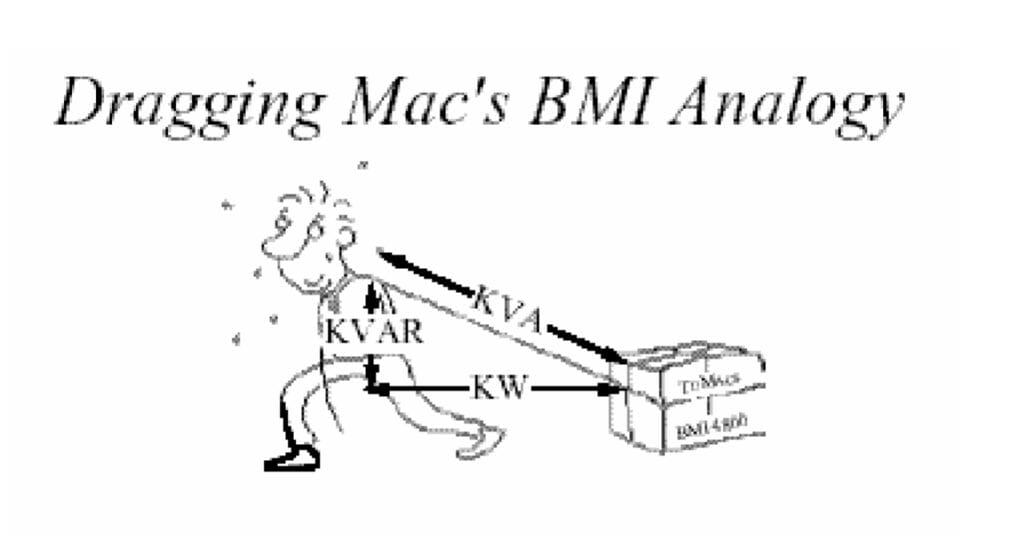
Important Points of the Power Triangle
- In an AC circuit, Active Power and Reactive Power are 90° apart.
- (kVA)² = (kW)² + (kVAR)²
Power Factor formula
Power Factor = cos φ = Active Power / Apparent Power = kW / kVA
Effect of Reactive Power
- The lower the Reactive Power, the higher the Power Factor.
Relationship:
kVAR = kVA sin φ = kW tan φ
note point
- If the current lags the voltage → it is called Lagging Reactive Power.
- If the current leads the voltage → it is called Leading Reactive Power.
Low Power Factor
In an AC system, a low power factor causes multiple problems, reducing system efficiency and increasing costs.
Disadvantages of Low Power Factor
1. Larger Conductor Size
- At low power factor, higher current flows, requiring an increase in the cross-section of cables and motor conductors.
Example:
- 10 kW, 250 V, Unity P.F. → Current = 10,000 / 250 = 40 A
- P.F. 0.8 → kVA = 10 / 0.8 = 12.5 kVA → Current = 12,500 / 250 = 50 A
2. Higher Copper Losses
- More current increases I²R losses, reducing energy savings.
3. Poor Voltage Regulation
- Higher current causes voltage drop in transformers and transmission lines.
- Result: Equipment performance degrades.
4. Reduced Handling Capacity
- Due to reactive current, the system cannot fully utilize its total capacity.
Causes of Low Power Factor
- Induction Motors:
- At light load, 1-phase or 3-phase motors may have P.F. as low as 0.2–0.3.
- At full load, P.F. rises to 0.8–0.9.
- Arc Lamps, Discharge Lamps, Industrial Heaters:
- Operate at low power factor.
- Load Fluctuations:
- Morning-evening demand variations and low-load high voltage increase magnetization current.
Power Factor Improvement
- Most loads are inductive, drawing lagging current.
- The power factor can be improved by connecting capacitors or other devices in parallel with the system.
- Capacitors draw a leading current that partially or fully neutralizes the lagging reactive current.
- As a result:
- Power Factor increases
- Current decreases
- System efficiency improves
To maintain the efficiency of an AC power system, it is essential to keep the power factor as close as possible to 1 (Unity).
A low power factor causes higher current flow, which increases losses in the system.
The simplest and most effective solution to this problem is the installation of capacitors.
Principle of Power Factor Improvement
When a capacitor is connected in parallel with the load,
it provides a current that leads the voltage by nearly 90°.
This reduces the total circuit current and improves the power factor.
- Active Power (kW) remains the same.
- Reactive Power (kVAR) decreases.
- As a result, the Power Factor increases.
Assume a single-phase load draws a current I with a power factor cos φ₁ (see Figure 6.3).
When a capacitor C is connected in parallel with the load, it draws a current I₍C₎, which leads the supply voltage V by 90°.
The new line current is the phasor sum of I and I₍C₎:
I′ = phasor sum of I and I₍C₎
The new lag angle is φ₂.
Since φ₂ < φ₁, it follows that cos φ₂ > cos φ₁, i.e., the load power factor improves.
Key Points
Reduction in Circuit Current
- After improvement, the new current I′ is less than the original current I.
Active Power Remains Constant
- The active (wattful) component does not change.
- Only the lagging reactive current is reduced.
Reduction in Reactive Current
- The new lagging reactive current is:
I′ sin φ₂ = I sin φ₁ − I₍C₎
- From this, the new line current can also be calculated as:
I′ = (I cos φ₁) / (cos φ₂)
Active Power (kW) Remains Unchanged
Active Power (kW) = V I cos φ remains the same as before.
Net Reactive Power Reduces
After improvement:
Net kVAR = Lagging kVAR (before) − Leading kVAR (from capacitor)

Main Equipment for Power Factor Improvement
Various devices are used to improve the power factor:
1. Static Capacitors
- The most common and simple method.
- Connected in parallel with 3-phase or 1-phase loads.
- Widely used in industries for motors and lighting loads.
Advantages
Reduced Power Losses – Current in the system decreases, saving energy.
Easy Maintenance – No rotating parts are involved.
Simple Installation – Lightweight and can be installed easily without a foundation.
Weather-Resistant – Works well in normal weather conditions.
Disadvantages
Limited Lifespan – Approximately 8–10 years.
Vulnerable to High Voltage – Can fail quickly if exposed to high voltage.
Expensive Repairs – Repair costs are high if the device is damaged.
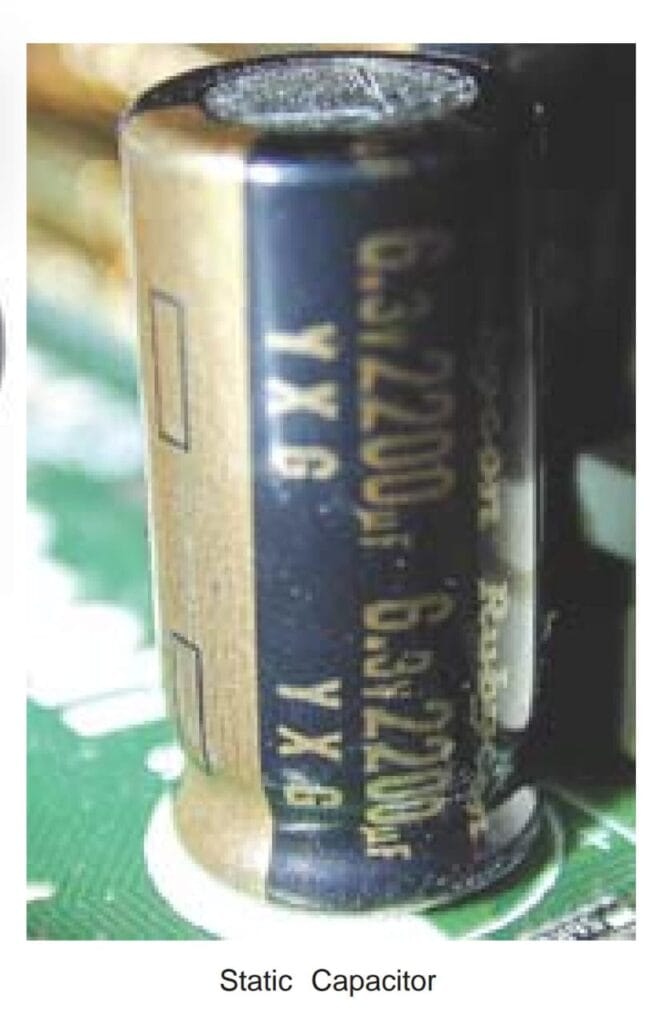
2. Synchronous Condenser
A synchronous condenser is an over-excited synchronous motor that supplies a leading current at no-load, reducing lagging reactive current and improving the power factor.
- A synchronous motor running at no load.
- By providing suitable excitation, it supplies a leading current.
- Suitable for large power systems to improve the power factor.
Advantages
Motor windings can withstand short-circuit currents.
Faults can be repaired easily.
Current and power factor controlled
Disadvantages
High power loss and maintenance costs.
Produces noise.
More expensive than static capacitors for ratings above 500 kVA.
Does not start by itself; requires separate starting equipment.
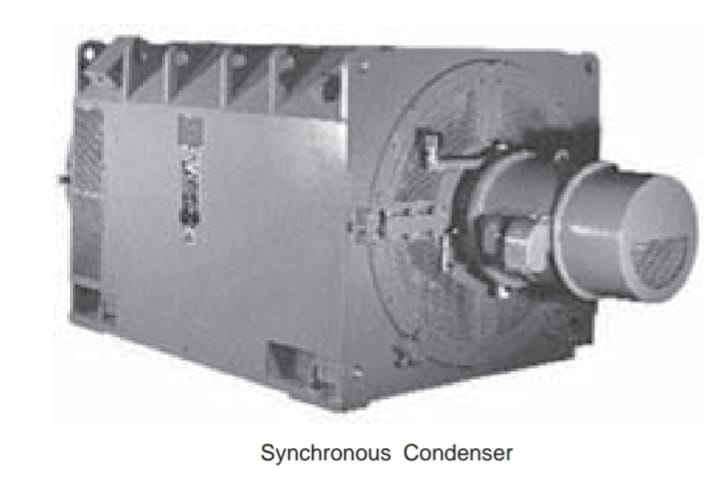
3. Phase Advancer
A phase advancer is specifically used to improve the power factor of induction motors.
- Specifically used for induction motors.
- Provides the motor field with the required leading current.
Working Principle
- Reduces the lagging current in the stator.
- Provides additional exciting current to the rotor at slip frequency, allowing the motor to operate at a leading power factor.
Advantages
Reduces lagging kVAR.
Easy alternative when synchronous motors are not used.
Disadvantages
Not economical for motors smaller than 200 H.P.
4. Capacitor Bank Installation
- Installing capacitors in parallel with the load produces leading current.
- This neutralizes the lagging reactive current of the load and increases the overall power factor.
Key Benefit: Capacitor banks are simple, cost-effective, and widely used for PF correction in industries and commercial setups.
note point;
In short, adding capacitors reduces reactive power and thereby improves the power factor.
A high power factor not only saves energy but also reduces electricity bills and system losses.
Comparison of Power Factor Correction Devices
| Feature | Static Capacitor | Synchronous Condenser | Phase Advancer |
|---|---|---|---|
| Main Function | Reduces stator lagging current and supplies additional exciting current to the rotor to improve the power factor | An over-excited synchronous motor operates like a capacitor at no-load, and provides leading current | Provides a leading current when connected in parallel with the load |
| Power Factor Improvement | Neutralizes lagging current to increase power factor | Reduces lagging reactive current to improve power factor | An over-excited synchronous motor operates like a capacitor at no-load, and provides a leading current |
| Maintenance | Very low, no rotating parts | Medium to high, motor and field excitation need care | Low, works with the induction motor |
| Installation | Easy, lightweight, minimal foundation required | Complex, heavy, requires foundation and starting equipment | Medium, requires rotor and stator integration with the motor |
| Lifespan | 8–10 years | Long, depends on motor life | Depends on motor life |
| Cost | Low (economical up to 500 kVA) | Expensive, especially above 500 kVA | Expensive for small motors, economical for large motors |
| Current Handling | Medium | Can handle high short-circuit current | Depends on motor rating |
| Noise | Nearly silent | Noisy | Nearly silent |
| Application | Small and medium industries or loads | Large power systems and high-capacity loads | Specifically for improving induction motor power factor; alternative when synchronous motor is not used |
Importance of Power Factor Improvement
The importance of Power Factor Improvement (PFI) can be understood from different perspectives – for consumers and generating stations.
1. For Consumers
- Both the maximum kVA demand and unit charges affect electricity bills.
- Improving the power factor reduces the maximum kVA demand, resulting in savings on annual demand charges.
- Although investment in PFI equipment is required, proper improvement leads to net annual savings.
✅ Example:
If an industry improves its power factor, its actual energy consumption (kWh) remains the same, but the total kVA demand decreases, leading to a lower electricity bill.
2. For Generating Stations
- Generators are rated in kVA, but the actual output in kW depends on cos φ:
Output kW = kVA × cos φ
- A high power factor means more kWh can be supplied, increasing revenue.
3. Most Economical Power Factor
- Power factor improvement reduces kVA demand and annual demand charges.
- However, PFI equipment involves investment, interest, and depreciation costs.
Net Annual Saving = Annual Demand Charge Saving – PF Equipment Cost
- The cos φ at which Net Annual Saving is maximum is called the Most Economical Power Factor.
Key Formula:
Maximum Demand (kVA) = Peak kW / cos φ
- If cos φ increases, kVA demand decreases.
- If cos φ decreases, kVA demand increases.
Benefits of Power Factor Improvement
Power factor improvement not only reduces electricity bills but also enhances system efficiency and equipment lifespan.
1. Cost Reduction
- Reduced Penalties & Losses – Lower reactive power decreases energy losses (I²R losses) and reduces utility penalties for low power factor.
- Infrastructure Savings – Less reactive current reduces the need for oversized transformers, cables, and other equipment.
2. Equipment Life & Maintenance
- Lower Current → Less Stress → Longer Lifespan
- Reduced current puts less load on equipment, increasing service life and reducing maintenance requirements.
3. Better Capacity Utilization
- Existing supply lines and transformers can be utilized closer to their full rated capacity without overloading.
- PF improvement ensures efficient use of infrastructure without unnecessary upgrades.
Load Management
Objective: Maintain a good power factor and reduce unnecessary load on the system.
Method:
- Operate highly inductive loads (such as large motors and induction furnaces) during off-peak hours (times of low demand).
- This reduces stress on the power supply, lowers peak demand charges, and improves the power factor.
2. System Efficiency Improvement
- Proper load balancing and timely maintenance of equipment reduce line losses.
- Along with power factor improvement, voltage drop decreases, enhancing the overall efficiency of the power supply.
Power Factor Measurement Techniques
- Direct Method
- Equipment: Power meter (Wattmeter) and Volt-Ampere meter.
- Procedure:
- Measure real power (kW) and apparent power (kVA).
- Calculate power factor:
PF = kW ÷ kVA
2. Indirect Method
- Equipment: Oscilloscope and PF meter.
- Procedure:
- Measure the phase difference (φ) between voltage and current.
- Calculate power factor:
PF = cos φ
3. Modern Digital PF Meters
- Modern meters automatically display the type of power factor:
- Lagging – Current lags voltage
- Leading – Current leads voltage
- Unity – Current and voltage are in phase
- Real-time monitoring and recording make maintenance easier.
FAQ
What is Power Factor?
Power factor is the ratio of real power (kW) used to do work to the apparent power (kVA) supplied to the circuit.
It shows how effectively electrical power is being used.
Formula: Power Factor (PF) = kW ÷ kVA = cos φ
A PF close to 1 means electricity is being used efficiently.. Why is Power Factor Important?
A good power factor reduces electricity bills, improves voltage stability, and increases the capacity of the electrical system.
A low power factor wastes energy, causes higher losses, and can lead to penalties from electricity providers.What causes Low Power Factor?
Common causes include:
Inductive loads such as motors, transformers, welding machines, and fluorescent lamps.
Poor wiring or overloading.
Operating equipment at light load.How does Low Power Factor affect consumers?
Low PF draws more current for the same power, leading to:
Higher electricity charges or penalties.
Increased line losses and heating.
Reduced capacity of transformers and generators.How can Power Factor be improved?
Power factor can be improved by adding equipment that provides leading reactive power:
Static capacitors
Synchronous condensers
Capacitor banks
Phase advancers for large motorsWhat is the ideal Power Factor value?
The ideal power factor is 1 (or 100%), known as unity power factor.
Practically, a PF of 0.95 or higher is considered good for most industries

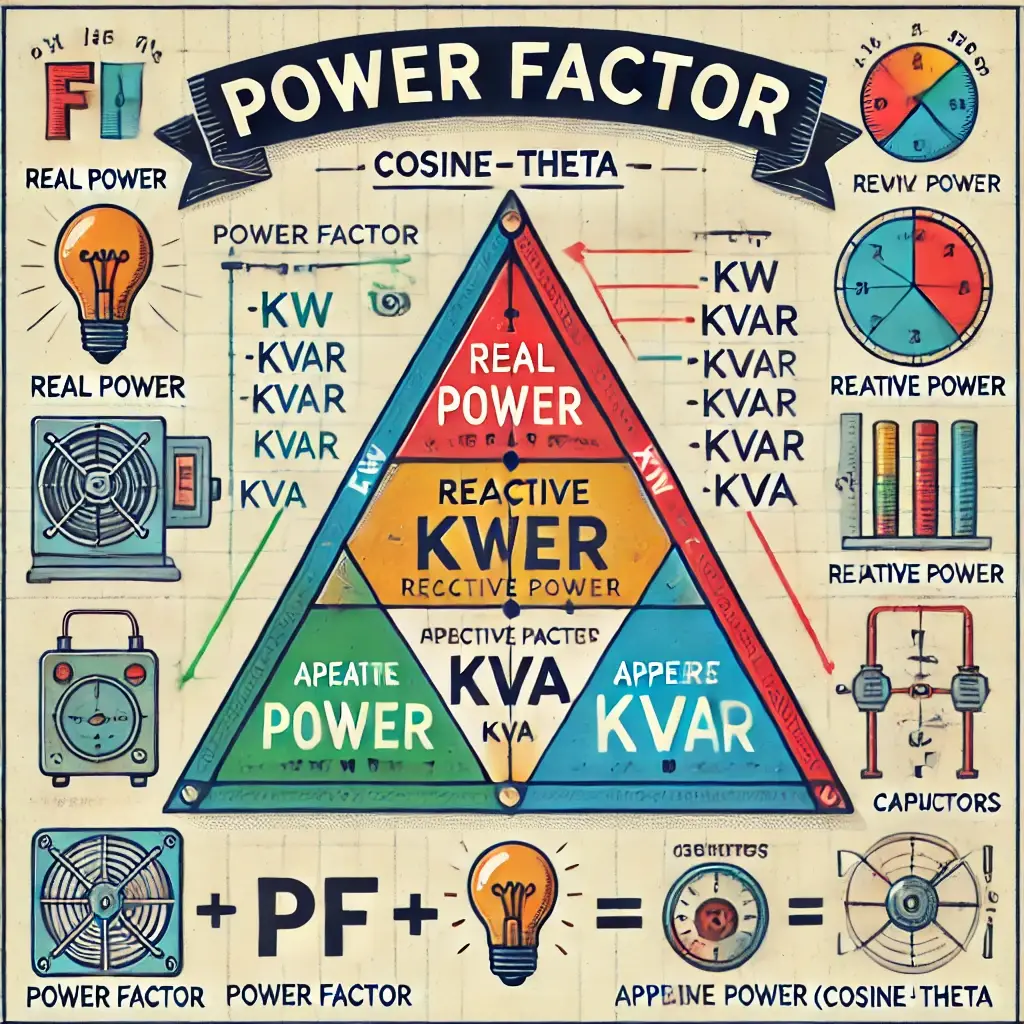
Hi, this is a comment.
To get started with moderating, editing, and deleting comments, please visit the Comments screen in the dashboard.
Commenter avatars come from Gravatar.